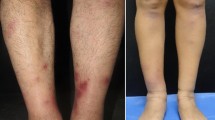Abstract
The anti-inflammatory activity of aspirin-like drugs could derive, at least in part, by inhibiting synthesis and release of prostaglandins or rabbit aorta-contracting substance from platelets. Indeed, aggregation of platelets and the consequent release of inflammatory mediators has been frequently evoked as a factor in the development of the inflammatory reaction. The participation of platelets in acute inflammation was tested in three types of trauma in rats rendered thrombocytopenic with anti-platelet serum. Oedema in response to carrageenin, anti-platelet serum or passive cutaneous anaphylaxis was no different from the controls in thrombocytopenic rats.
Similar content being viewed by others
References
O'Brien, J. R.,Effect of salicylates on human platelets, Lancet1, 779–783 (1968).
O'Brien, J. R.,Effect of anti-inflammatory agents on platelets, LancetII, 894–895 (1968).
Robertson, A. L., and Khairallah, P. A.,Effects of angiotensin II on the permeability of the vascular wall, in:Angiotensin (Eds I. H. Page and F. M. Bumpus; Springer Verlag, 1974), p. 500–510.
Vargaftig, B. B.,Search for common mechanisms underlying the various effects of putative inflammatory mediators, in:The Prostaglandins, Vol. 2 (Ed. P. W. Ramwell; Plenum Press, New York 1974), 205–276.
Redei, A., and Kelemen, E.,Presence of platelets in acute experimental inflammatory oedema inhibited by salicylate or cortisone, in:Inflammation Biochemistry and Drug Interaction (Eds A. Bertelli and J. C. Houck; Excerpta Medica Foundation, Amsterdam 1969), p. 261–265.
Gorog, P., and Kovacs, I. B.,The alteration of platelet behaviour during various conditions and the effect of anti-inflammatory agents on platelet aggregation and thrombus formation, in:Inflammation Biochemistry and Drug Interaction (Eds A. Bertelli and J. C. Houck; Excerpta Medica Foundation, Amsterdam 1969), p. 197–203.
Silver, M. J., Smith, J. B., and Ingerman, C. M.,Blood platelets and the Inflammatory process, Agents and Actions4, 233–240 (1974).
Smith, J. B., and Willis, A. L.,Aspirin selectively inhibits prostaglandin production in human platelets, Nature, New Biol.231, 235–237 (1971).
Vargaftig, B. B., and Zirinis, P.,Arachidonic acid-induced platelet aggregation accompanied by release of potential inflammatory mediators distinct from PGE 2 and PGF 2α. Nature New Biol.244, 114–116 (1973).
Willis, A. L.,Isolation of a chemical trigger for thrombosis, Prostaglandins5, 1–24 (1974).
Hamberg, M., Svensson, J., Wakabayashi, T., and Samuelsson, B.,Isolation and Structure of two prostaglandin endoperoxides that cause platelet aggregation, Proc. Nat. Acad. Sci.71, 345–349 (1974).
Ubatuba, F. B., Harvey, E. A., and Ferreira, S. H.,Are platelets important in inflammation? Agents and Actions5, 31–34 (1975).
Willis, A. L.,Parallel assay of prostaglandin-like activity in rat inflammatory exudate by means of cascade superfusion, J. Pharm. Pharmac.21, 126–128 (1969).
Di Rosa, M., Giroud, J. P., and Willoughby, D. A.,Studies of the mediators of the acute inflammatory response induced in rats in different sites by carrageenin and turpentine, J. Path.104, 15–29 (1971).
Ferreira, S. H., Moncada, S., Parsons, M., and Vane, J. R.,The concomitant release of bradykinin and prostaglandin in the inflammatory response to carrageenin, Br. J. Pharmac.23, 74–81 (1973).
Garcia Leme, J., Hamamura, L., Migliorini, R. H., and Leite, M. P.,Influence of diabetes upon the inflammatory response of the rat. A Pharmacological analysis, Eur. J. Pharmac.23, 74–81 (1973).
Moncada, S., Ferreira, S. H., and Vane, J. R.,Prostaglandins, aspirin-like drugs and the oedema of inflammation, Nature246, 217–219 (1973).
Thomas, G., and West, G. B.,Prostaglandins as regulators of bradykinin responses, J. Pharm. Pharmac.25, 747–748 (1973).
Williams, T. J., and Morley, J.,Prostaglandins as potentiators of increased vascular permeability in inflammation, Nature246, 215–217 (1973).
Lewis, A. J., Nelson, D. J., and Sugrue, M. S.,Potentiation by prostaglandin E 1 and arachidonic acid of inflammation in the rat's paw induced by various phlogogenic agents, Br. J. Pharmac.50, 468P-469P (1974).
Rothschild, A. M.,Pharmacodynamic properties of cellulose sulphate and related polysaccharides — a group of bradykinin releasing compounds, in.International symposium on vasoactive polypeptides: Bradykinin and related kinins (Eds M. Rocha e Silva and H. Rothschild. São Paulo, edart., 1967), p. 197.
Brune, K., Minder, B., Glatt, M., and Schmid, L.,Dopolymorphonuclear leucocytes function as mediators in acute inflammation? In:Future Trends in Inflammation I (Eds G. P. Velo, D. A. Willoughby and J. P. Giroud; Piccin Medical Books, 1974), p. 289–300.
Oor, T. C. S., Riley, P., and Doe, J. E.,Potentiated reagin response to egg albumin in nippostrongylus braziliensis infected rats; II Time-course of the reagin response, Immunology20, 185–189 (1969).
Goose, J., and Blair, A. M. J. S.,Passive cutaneous anaphylaxis in the rat induced with two homologous reaginlike antibodies and its specific inhibition with disodium cromoglycate, Immunology16, 749–760 (1969).
Ferreira, S. H., Moncada, S., and Vane, J. R.,Prostaglandins and the signs and symptoms of inflammation, in:Prostaglandin Synthetase Inhibitors (Eds H. J. Robinson and J. R. Vane; Raven Pres, New York 1974) p. 175–187.
Ferreira, S. H.,Prostaglandins and the immunological trauma, Proceedings of VIII European Rheumatology Congress, in press (1975).
Van Arman, G. G. Begany, A. J., Miller, L. M., and Plesse, H. H.,Details of the inflammation caused by yeast and carrageenin, J. Pharmac. exp. Ther.150, 328–334 (1965).
Elliott, R. H. E., Jr., and Whipple, M. A.,Observations on the interrelationship of capillary, platelet and splenic factors in thrombocytopenic purpura, J. Lab. clin. Med.26, 489–498 (1940).
Ackroyd, J. F.,Allergic purpuras, including purpuras due to foods, drugs and infections, Am. J. Med.14, 605–632 (1953).
Margaretten, W., and McKay, D. G.,The requirement for platelets in the active Arthus reaction, Am. J. Path.64, 257–263 (1971).
Author information
Authors and Affiliations
Rights and permissions
About this article
Cite this article
Ferreira, S.H., Ubatuba, F.B. & Vane, J.R. Platelets, acute inflammation and inflammatory mediators. Agents and Actions 6, 313–319 (1976). https://doi.org/10.1007/BF01972248
Issue Date:
DOI: https://doi.org/10.1007/BF01972248




